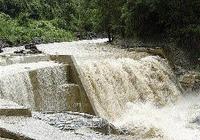Gareth Manning, Sunday Gleaner Reporter
In this October 2005 photo, flood waters overflow the catchment for the Mona Dam on Gordon Town Road in St. Andrew, following heavy rains. The island's freshwater sources, like this, are being polluted, states a government report. - Norman Grindley/Deputy Chief Photographer
The country's over 2.6 million people are becoming a burden on its freshwater sources, according to a recent report by the Statistical Institute of Jamaica (STATIN).
Jamaica's freshwater comes from two sources: surface and groundwater. Surface water sources include rivers, lakes, springs, streams and estuaries. Groundwater sources are obtained from empty spaces in rocks and sediments.
According to the 'Environment Statistics and Water 2005' report, the island's freshwater ecosystems are being overexploited and are being affected by the expulsion of sewage effluent and industrial and toxic waste from homes and businesses. About 10 per cent of groundwater has had to be abandoned due to the intrusion of salt water or other pollutants into aquifers (rocks containing fresh water), the report states.
A very valuable resource
"The use of freshwater, especially ... from natural resources such as rivers and lakes has increased over time," the report indicates. "As the population grows and water is used more and more for domestic purposes, agriculture and industry, water has become a very valuable resource," the report continues. Jamaica's population grows by half a percentage point each year, particularly in the parishes of St. Catherine and Clarendon where the population grew four per cent and three per cent respectively in the last six years.
The researchers note that incidents of algal blooms that lead to eutrophication are widespread in freshwater due to agricultural run-off caused from fertilising and irrigation, soil tilling or forest clearing. Eutrophication is a process that leads to rapid growth of plant life in water, particularly algae, which compete with aquatic animals for air.
Highly contaminated
According to the report, studies by the International Centre for Environmental and Nuclear Sciences at the University of the West Indies, Mona, have shown that some of Jamaica's waters are highly contaminated by nitrates. The higher values are typically found in the central and western parts of the island where agriculture is practised more actively.
However, the report points out that half the water in the Liguanea basin which serves the parishes of Kingston and St. Andrew, has been contaminated by nitrates.
The STATIN document also states that potable water is being affected by nitrate pollution. "Potable water is being contaminated by mineral fertilisers, pesticides and herbicides which seep into surface and underground waters," the report discloses. "The use of rivers and other water bodies as well as unregulated dumping of sewage, industrial wastes and toxins pollute and threaten one of our most valuable resources."
This could be a possible explanation for the high dissatisfaction with water quality reported in several parishes.
Over 20 per cent of people are dissatisfied with the quality of their water, the report reveals, particularly in the parishes of Hanover, St. Mary, St. Ann and Clarendon. The complaints by citizens range from bad taste and smell of their water to discolouration and deposits in the water.
Discoloured water
The highest percentage of people reported discoloured water was a problem. This was particularly the case in Hanover, where 60 per cent of residents reported this problem. In St. Ann, 57 per cent of residents reported having deposits in their tap water, and 54 per cent in Clarendon complained of abad taste and smell.
"In order to lessen the costs of providing water for domestic consumption, a higher quantity of rainfall is needed. This will lead to a decreased risk of water contamination and disease," the report concludes.

